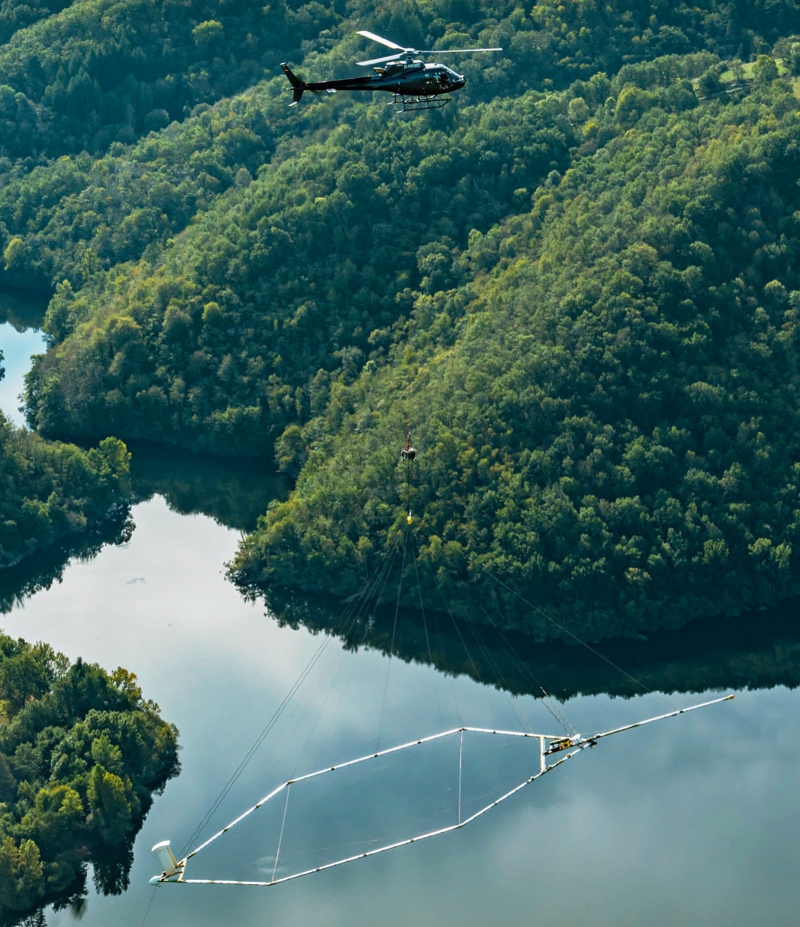Heli-borne geophysical acquisition campaign in the Massif Central (2023). © Alexandre Magnan
Inventory of mineral resources
Launch of the programme to update the National Inventory of France's Subsurface Mineral Resources
On the occasion of the Ecological Planning Council in September 2023, the French President announced that the Inventory of France's Subsurface Mineral Resources (IRM) would be updated. This decision was taken following the adoption of the CRM Act in Europe in December 2023, and was in line with the political impetus provided by the conclusions of the "Varin Report" in France. This initiative aims to identify areas that might have mineral resources of interest, with a view to reducing our dependence on imports of primary and secondary materials. This updating process is also designed to guarantee France's security and sovereignty in terms of the supply of mineral resources, while promoting more efficient and sustainable use of these resources, which will help to strengthen the resilience of our economy.
The benchmark national mining inventory was carried out between 1970 and 1995 and is now obsolete for a number of reasons:
- More than 30% of the "areas of potential interest" (bedrock domains and their Mesozoic boundaries) were not studied during the previous campaign (Cassard et al., 2012; Bertrand et al., 2016) due to the existence of exclusive research permits (PER) held by private operators in these areas at the time.
- Mineral exploration techniques have improved considerably in recent years, taking advantage of the major technological advances that have emerged since the 1980s (e.g. large-scale geophysical surveys, geochemical analytical techniques).
- The inventory carried out in the 1980s focused on certain substances that corresponded to the priorities of the time. Many other substances, which are now regarded as critical and strategic, were neither searched for nor analysed (lithium, tantalum, caesium, gallium, germanium, hafnium, etc.), or their detection limits were far too high to enable geochemical anomalies to be identified. The new inventory will correct this major bias. With this in mind, the main objective of the IRM project is to focus specifically on strategic exploration phases aimed at identifying the most favourable areas for the presence of mineral resources.
The challenges to be met
The success of this new nationwide inventory will require meeting a number of challenges:
- The logistic challenge of deploying significant ground and airborne acquisition campaigns across the country.
- Mobilising and coordinating a French ecosystem that has become fragmented, due to a lack of regular activity in France over the last thirty years.
- Creating added value and cutting-edge innovation with a dynamic approach, which is open to the creation of partnerships.
- Rolling out an effective communication campaign and appropriate scientific mediation process to explain the political, economic and societal motivation behind the work, as well as the technical details of the action undertaken.
The organisation
BRGM worked on the preliminary design of the IRM in collaboration with the French Inter-ministerial delegation for the supply of strategic minerals and metals (DIAMMS), the General Directorate for Spatial Planning, Housing and the Natural Environment (DGALN) and the General Secretariat for investment (SGPI). The IRM's technical programme was decided on the basis of multidisciplinary criteria, incorporating both scientific and public policy priorities. The resulting programme is designed to maximise the identification of areas of interest while ensuring consistency with regional policies.
The various working methods (e.g. geochemistry, geophysics, geology) should make it possible to identify deposits that are "hidden under a cover" (and therefore not detectable on the surface) and have never been identified in the past, or deep-sitting extensions of previously identified deposits.
Consequently, the project has been designed to take account of the following parameters:
- Rapid operational implementation, starting at the end of 2024 and taking five years to complete.
- Regular publication of results/deliverables throughout the process.
- The use of the most effective and innovative approaches and technologies in order to optimise the quality of the results, particularly in the field of artificial intelligence and data sciences.
- Close collaboration with the French research ecosystem and innovative companies, as well as with the international network of Geological Surveys.
- The organisational agility required to ensure sufficient responsiveness to complete the project. BRGM will be the sole leader of the programme.
To carry out all this work, it will draw on the services of various subcontractors, notably including a subsidiary called BRGM EXPLORE, which will be responsible for the operational implementation of the technical programme, with BRGM handling the administrative, financial and scientific management (innovation, interpretation, dissemination).
As regards the operational implementation, BRGM EXPLORE will also be able to call on specialist subcontractors, in particular for airborne-campaign flights, the collection of sediment samples and multi-element laboratory analyses.






